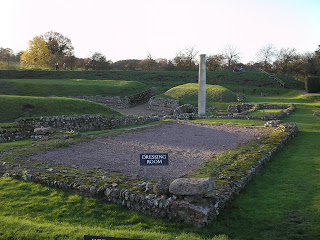Saint Alban
Today on some calendars is the Feast Day of Saint Alban, reputedly the first Christian Martyr in England. Saint Alban is mentioned in "Acta Martyrum", and also by Constantius of Lyon in his Life of St Germanus of Auxerre, written about 480.What we know of Alban also comes from the history of the Venerable Bede who died circa AD 735.
Alban lived in the Roman period in Britain in a town called Verulamium, near the current Cathedral of St. Albans north of London. The ruins have been excavated. I visited them some years ago when I was living in England. Archaeology being a hobby of mine, I and have some pictures:
Mainly what you are seeing is the Roman earthen amphitheater.
Closer to St Alban's Cathedral, you can still see some of the original Roman walls:
(I had more hair back then...)
Of course, there is St. Alban's Cathedral itself, which is quite lovely:

Most know the Christian story of Alban by Bede, which is worth a read here (it's short). There is more on the saga of St. Alban, however. The following picture is his tomb in St. Alban's cathedral, which itself has an interesting story:
Apparently in the Puritanical aftermath of Reformation era iconoclasm, many holy sites (prior to the Reformation, this was one of the high holy places in all of England) that contained relics were smashed to bits, lest there be any remnants of "Catholick popery" and "saint worship" left in the realm. St Alban's tomb here was itself taken into the court yard and smashed.
Historians in the subsequent centuries assumed that the grand tomb of the first English martyr was lost to antiquity, until in the late 1800's when an addition was being made to St Alban's cathedral. A brick mason tore off the plaster and mortar on a wall in St. Alban's cathedral that was scheduled for removal. As he was tearing down the wall, he noticed the rocks in the foundation were very strange indeed. Some appears to have writing or depictions of something on them. Instead of chucking them in the rock quarry, the British museum was consulted.
Turns out after the Puritans had smashed the tomb to pieces, subsequent builders reused the pieces as a foundation. British historians quickly realized that by historical happenstance, they had uncovered the original tomb of St. Alban! They were able to reconstruct such a national and religious treasure to its original appearance after almost two centuries. That is what you see in the picture above.You can still visit the shrine in St. Alban's Cathedral to this day.
As Radio Announcer, Paul Harvey, used to say, "And now you know the rest of the story..."
Alban lived in the Roman period in Britain in a town called Verulamium, near the current Cathedral of St. Albans north of London. The ruins have been excavated. I visited them some years ago when I was living in England. Archaeology being a hobby of mine, I and have some pictures:
Mainly what you are seeing is the Roman earthen amphitheater.
Closer to St Alban's Cathedral, you can still see some of the original Roman walls:
(I had more hair back then...)
Of course, there is St. Alban's Cathedral itself, which is quite lovely:

Apparently in the Puritanical aftermath of Reformation era iconoclasm, many holy sites (prior to the Reformation, this was one of the high holy places in all of England) that contained relics were smashed to bits, lest there be any remnants of "Catholick popery" and "saint worship" left in the realm. St Alban's tomb here was itself taken into the court yard and smashed.
Historians in the subsequent centuries assumed that the grand tomb of the first English martyr was lost to antiquity, until in the late 1800's when an addition was being made to St Alban's cathedral. A brick mason tore off the plaster and mortar on a wall in St. Alban's cathedral that was scheduled for removal. As he was tearing down the wall, he noticed the rocks in the foundation were very strange indeed. Some appears to have writing or depictions of something on them. Instead of chucking them in the rock quarry, the British museum was consulted.
Turns out after the Puritans had smashed the tomb to pieces, subsequent builders reused the pieces as a foundation. British historians quickly realized that by historical happenstance, they had uncovered the original tomb of St. Alban! They were able to reconstruct such a national and religious treasure to its original appearance after almost two centuries. That is what you see in the picture above.You can still visit the shrine in St. Alban's Cathedral to this day.
As Radio Announcer, Paul Harvey, used to say, "And now you know the rest of the story..."









Comments